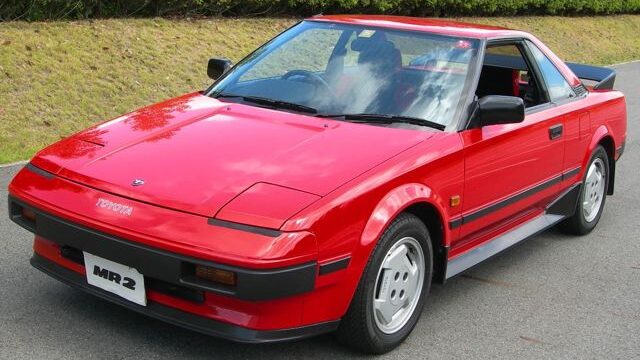Kim Henson takes a close look at another ‘modern classic’ launched since the Western Group of Motoring Writers was established.
With three fascinating decades of our Group now having flown by, in my series of 12 features labelled ‘Back to the Future Classics’, and appearing on our website through 2013, I am looking back at a selection of models seen as especially important.
Together, the vehicles I’ve chosen show how times have changed across the motor industry during the last 30 years, and, I feel, represent “12 of the most significant future classics launched in that time”. So put on your nostalgic spectacles again, and cast your mind back.
Back in the spring of 1985, a sporty newcomer from Toyota reached British shores.
The new MR2 (‘mid-engined, runabout two seater’) was a distinctively angular fixed head coupé, notably featuring Toyota’s fuel-injected 16 valve, twin overhead camshaft 4A-GE ‘A Type’ 1587cc power unit (also used in the contemporary front wheel drive Corolla), driving the rear wheels via a five speed all-synchromesh gearbox.
Greatly aiding its overall performance, the engine incorporated Toyota’s revolutionary ‘Twin Venturi Induction System’ (‘TVIS’), the inspired forerunner of later VTEC and VVT systems.
The model found instant favour with the motoring press and buyers, for its combination of lively performance, go-kart like handling and the sheer fun of driving it.
By today’s standards, 122 bhp doesn’t sound a great deal, but in 1985 it endowed the MR2 with what was considered to be very rapid acceleration (zero to 60 mph from rest in just 7.9 seconds) and the motor was especially eager when buzzing at high rpm. Indeed this rev-happy engine developed its maximum output at a relatively high 6,600 rpm. Yet, fun though the car was on the open road, where it excelled, it was also docile in low speed town use. The performance potential and willingness of the engine was complemented by a sweet-changing gearbox with a short-throw gearchange.
The running gear specification was impressive for the mid-1980s too. All-independent suspension was employed, incorporating gas-filled dampers all-round, plus anti-roll bars at both the front and rear. Test drivers of the time were full of compliments for the manner in which the car handled, but also for its compliant ride quality.
Servo-assisted dual circuit brakes were fitted, with discs at the front and rear (the front discs were ventilated), and again their performance won wide praise.
In typical Toyota fashion, the MR2 was exceedingly well-equipped, featuring lightweight aluminium sports road wheels, retractable headlamps, a front airdam, a rear spoiler, tinted glass, a ‘pop-up’/removable sun roof (with a detachable interior shade), high-backed sports seats (the driver’s seat was adjustable for side and lumbar support, plus seat cushion height), electrically-operated door windows and mirrors, central locking, a centre console and a three waveband radio/cassette player stereo system.
The comprehensive instrumentation included a tachometer, oil pressure gauge, voltmeter and digital clock.
In October 1986 a ‘T’ bar version was introduced, with twin removable glass roof panels, enabling easy conversion, when desired, of the car to open top mode. The frontal styling and body side vents were revised, and new road wheels were fitted. Leather upholstery was offered as an option.

The interior was upgraded too, with a new centre console, improved trim, push-button heating/ventilation controls, and a revised four speaker stereo system.
At the same time the suspension was improved, and larger brakes installed. From October 1988 leather upholstery became a standard fitting on T bar versions.
PRACTICAL TOO?
The multi-adjustable seats in the MR2 have been appreciated by many owners over the years, for their comfort over long distances. I did too, when road-testing an early example over several hundred miles, in 1985, and when re-acquainting myself with the model a few years ago.
In truth, the luggage accommodation in the MR2 was never spectacularly spacious. So, for example, there is nowhere large enough to stow normal suitcases. On the other hand, the car does feature two separate ‘boots’, both being ideal for the carrying of soft bags. There’s a small compartment (where the spare wheel also lives) at the front of the car, and a separate, wide, fairly deep locker behind the engine.
Fuel consumption is good, with over 40 mpg easily attainable during normal long-distance driving, while in-town use will typically see figures in the low thirties, per gallon.
Although the engine bay is tightly packed, most aspects of maintenance are straightforward (although the essential task of occasionally renewing the camshaft drive belt – ideally at least every 40,000 miles – is time-consuming).
Consistently impressive reliability has always been a strongpoint of the model, which helps to explain why, nearly 30 years after the model’s introduction, many survivors are still used and enjoyed on a daily basis.
VERDICT
Truly, a classic in its own time.
The first MR2 model was discontinued in April 1990, to make way for the totally restyled, two litre ‘Mark 2’ MR2. Many enthusiasts were sorry to see the demise of the original MR2, but today the surviving examples are cherished as classics, and quite deservedly so. Indeed, when, in early 1985 I test-drove – and loved – one of the very first MR2s in Britain, I wrote that I felt that the model was destined for ‘instant’ classic status. It’s great to be right, sometimes.
© Kim Henson Images sourced thanks to Virtual Motorpix

